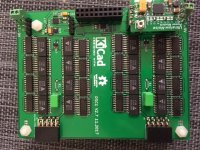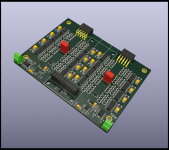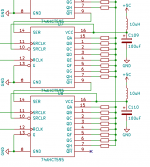provide simple connectors to allow a variety of power supply types to be used
Ray
This would be the best way to go.
Hi Pavel, I'm still really enjoying my DSC2 - thanks.
Regarding a 'final' version, In my opinion you should keep your board very simple, essentially as you have it now, with a choice of output configuration. Keeping it simple gives people maximum choice, from a basic Amanero/DSC2 configuration to all sorts of options for offboard isolation/reclocking/upsampling/etc modules and enables upgrade experimentation. Trying to accomodate everyone's preferences will probably be impossible anyway.
The only change I suggest is to discard the plug-in power supply modules and provide simple connectors to allow a variety of power supply types to be used, which fits with my theme of maximum choice
Ray
As real-life user of DSC2, same as @ nautibuoy, I totally agree with this: keep it as is - simple.
Give us a way to use a custom output stage and we’re golden.
If I recall correctly, even now one can pull out the PSU modules and provide his own regulation, right Pavel?
While I do support the simple is better approach, I feel an XO on board, with a re-clocking Flip Flop (Potato chip) for DSDR, DSDL, and bit clock, with clock output to the source for slaving, would be an advantage. Having the masterclock right there, and having a re-clock right at the input, would result in lowest possible jitter.
It would also be nice if the footprint accepted the Pulsar clock as well as other choices (NDK, Crystek 575, and 957 series).
My understanding is that clock accuracy is critical for DSD.
It would also be nice if the footprint accepted the Pulsar clock as well as other choices (NDK, Crystek 575, and 957 series).
My understanding is that clock accuracy is critical for DSD.
Last edited:
If I recall correctly, even now one can pull out the PSU modules and provide his own regulation, right Pavel?
Yes. that's what I have done with my DSC2, but simpler connections for just +ve and gnd would be easier and make it harder to make a wrong connection.
While I do support the simple is better approach, I feel an XO on board, with a re-clocking Flip Flop (Potato chip) for DSDR, DSDL, and bit clock, with clock output to the source for slaving, would be an advantage. Having the masterclock right there, and having a re-clock right at the input, would result in lowest possible jitter.
It would also be nice if the footprint accepted the Pulsar clock as well as other choices (NDK, Crystek 575, and 957 series).
My understanding is that clock accuracy is critical for DSD.
That would suit me as isolation and reclocking is what I'm going to experiment with on my current DSC2 (assuming it improves the SQ of course) but I'm thinking it might not be for everyone and it's not such a compromise to have the isolator/reclocker offboard but sat right on the input? You'll need to facilitate dual oscillators and a clock select mechanism too.
While I do support the simple is better approach, I feel an XO on board, with a re-clocking Flip Flop (Potato chip) for DSDR, DSDL, and bit clock, with clock output to the source for slaving, would be an advantage. Having the masterclock right there, and having a re-clock right at the input, would result in lowest possible jitter.
It would also be nice if the footprint accepted the Pulsar clock as well as other choices (NDK, Crystek 575, and 957 series).
My understanding is that clock accuracy is critical for DSD.
+1
Let's be realistic. DSC sounds great. This is confirmed by many owners of this DAC.While I do support the simple is better approach, I feel an XO on board, with a re-clocking Flip Flop (Potato chip) for DSDR, DSDL, and bit clock, with clock output to the source for slaving, would be an advantage. Having the masterclock right there, and having a re-clock right at the input, would result in lowest possible jitter.
It would also be nice if the footprint accepted the Pulsar clock as well as other choices (NDK, Crystek 575, and 957 series).
My understanding is that clock accuracy is critical for DSD.
The FIR design with a rectangular window is not sensitive to the jitter. The quality of Amanero generators is sufficient for a good sound.
The use of Potato and additional XO unnecessarily complicates and increases the cost of this design.
I really like the simplicity and elegance of DSC. And I think that minimalism is the reason for the phenomenal sound.
And I think the use of DSC together with HQPlayer is an ideal pair with a reference sound.
In the release, I'll save the LDO. They will be installed directly on the board. And it will be possible to connect a separate power supply. But my opinion is that this DAC good LC filters for each chip allow us to use cheap LDO without loss of quality.
I also envisaged the possibility of installing resistors of different sizes 0603-1206.
P.S. I have a v2.7 with resistor networks Vishay TOMC1603. Unfortunately, TOMC is discontinued. But there is a modern replacement - NOMC. The sound of this version I like most. But these resistors are quite expensive.
Attachments
I do not think that the resistor can significantly influence. I have retained measurements of the non-balanced version of DSC1. Very similar to the measurement of the version with FF. And most importantly, both options have an unpleasant correlation noise.
I'm just a bit curious how do you get some audible/measurable noise from the original DSC1, because I don't get any... I wonder what is the difference...
A very valuable option to my view should be the implementation of a AK4137 module. This will enable hardware PCM to DSD conversion on the fly (like the new Terra-Berry DAC 2). In rhis way one could play a PCM library from slim hardware (like RPi).
Except that the quality is horribly bad, what I've seen...
hey...
Hey Pavel, thank you for all of your work on this project! I really look forward to trying it.
Let's be realistic. DSC sounds great. This is confirmed by many owners of this DAC.
The FIR design with a rectangular window is not sensitive to the jitter. The quality of Amanero generators is sufficient for a good sound.
The use of Potato and additional XO unnecessarily complicates and increases the cost of this design.
I really like the simplicity and elegance of DSC. And I think that minimalism is the reason for the phenomenal sound.
And I think the use of DSC together with HQPlayer is an ideal pair with a reference sound.
In the release, I'll save the LDO. They will be installed directly on the board. And it will be possible to connect a separate power supply. But my opinion is that this DAC good LC filters for each chip allow us to use cheap LDO without loss of quality.
I also envisaged the possibility of installing resistors of different sizes 0603-1206.
P.S. I have a v2.7 with resistor networks Vishay TOMC1603. Unfortunately, TOMC is discontinued. But there is a modern replacement - NOMC. The sound of this version I like most. But these resistors are quite expensive.
Hey Pavel, thank you for all of your work on this project! I really look forward to trying it.
Measuring these noises is difficult. Digitized a musical fragment with a low volume from DSD256 to WAV. These noises appear only at a weak signal level and at high bit rates of DSD256 or DSD512. I do not have the original DSC1. The measurement was made with the Chinese clone DSC1. The version with FF (v3.0) has the same noise.I'm just a bit curious how do you get some audible/measurable noise from the original DSC1, because I don't get any... I wonder what is the difference...
Right now there so many good options for oversampling to DSD in software players (Audirvana Plus, ROON, Daphile, JRiver, HQPlayer, etc) that it is unnecessary to do the conversion in hardware.
These software players also take advantage of the far greater computing power available, in an actual computer, and do much better conversions as well. Adding an oversampling chip directly to this design would just add unnecessary complexity, and it could increase the local noise footprint as well (it is DSP after all). To me one of the big advantages of doing the conversion process this way is that it has a very low noise footprint on the board.
Simplicity is a good objective to pursue in order to get the better sound quality. Certainly DSP processing inside AK4137 may cause alterations (I never had the opportunity to hear it). Maybe also CPU processing inside a PC is not free of problems... but software can become better and better.
I agree with simplicity at its best
The only change I suggest is to discard the plug-in power supply modules and provide simple connectors to allow a variety of power supply types to be used, which fits with my theme of maximum choice
Ray
Sorry, I could not agree on this.
The onboard PSU/reg provides proven and acceptable power quality to the DSC, it is sufficient to majority of users.
To allow the usage of external PSU/reg, additional power supply input pins can be designed in between onboard PSU/reg circuits and DSC, so external PSU/reg can be used when the onboard PSU/reg is not populated.
Sorry, I could not agree on this.
The onboard PSU/reg provides proven and acceptable power quality to the DSC, it is sufficient to majority of users.
To allow the usage of external PSU/reg, additional power supply input pins can be designed in between onboard PSU/reg circuits and DSC, so external PSU/reg can be used when the onboard PSU/reg is not populated.
I have the previous DSC2.5 version and the PSUs can be pulled out. I don’t see an issue keeping that, unless Pavel is planning on soldering the units in place, which I doubt.
Pavel has already indicated his preferred power suppy arrangements for the 'final' version, see post #627
In the release, I'll save the LDO. They will be installed directly on the board. And it will be possible to connect a separate power supply.
The following changes were made:
- The design will be with a replaceable output module.
- Inverted Amanero.
- Replaced OS-CON with organic tantalum capacitors KEMET. Better SNR and less 2nd harmonic.
- It is possible to install resistors of any size 0603-1206.
- LDO ADP7118 is installed on the board. But jumper JP5 and JP6 allow using an external power supply.
Attachments
- It is possible to install resistors of any size 0603-1206.
This is Great!
- LDO ADP7118 is installed on the board. But jumper JP5 and JP6 allow using an external power supply.
Any reason ADM7150 is not used here?
Last edited:
ADM7150 is a good LDO. But...Any reason ADM7150 is not used here?
The reasons are enough. 🙂
- Each chip receives power through an LC filter of 10uH+100uF. Therefore, good noise parameters are not required.
- Connecting the ADM7150 is a bit more complicated.
- The price is higher.
Attachments
- Home
- Source & Line
- Digital Line Level
- Signalyst DSC1


